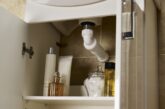
Waterless traps: why make the switch? Steve Skeldon, above ground product manager at Wavin, talks us through the alternatives to traditional traps.
When it comes to installing a water trap, you might decide to stick with what you know and choose a traditional option. However, if properties are left unoccupied for long periods of time, or drainage systems aren’t properly maintained, these can sometimes dry out and fail, meaning sewer gases can make their way back into living spaces.
Most of the issues that crop up with traditional water traps are caused by a loss of seal, or damage to the seal. This is becoming more of a problem with more complex housing designs which cause more fluctuations in water pressure and subsequently a greater impact on seals. If a property has traditional water traps, this fluctuation can cause siphonage in the system, which may eventually break the seal and cause the trap to fail. A failure can cause a number of problems, including foul sewer gases entering the property.
When a property is left vacant for an extended period of time, there’s an added risk of a trap drying out, which can lead to failure in the seal. This is a particular issue for people who own holiday homes, or additional properties that might have been empty during recent lockdowns. It’s also a concern for facilities managers and those responsible for hygiene in commercial spaces as many of them have been unused since early 2020.
Setting seal failure aside, water-filled traps are also prone to blockages, waste build-up and even leakage, which are all require tricky maintenance or replacement to repair. However, all of this is preventable if alternative trap solutions are used in homes instead.
Making the change
Waterless traps, as the name suggests, replace the ‘trapped’ water that you’d normally see in this valve with a robust, soft silicone, rubber membrane. Waterless traps also minimise the risk of leaking compared with traditional options, so you’re much less likely to be called back to fix a problem down the line. The lack of water sat stagnant in the system also means that these are a great option for an overall more hygienic and healthier environment within the home.
It’s not just the customers that reap the many rewards of waterless traps though, as some, including Wavin HepVO are designed specifically with those installing them in mind. Due to its unique design, HepVO can be fitted quickly and easily both horizontally or vertically, as there’s no need to accommodate the water reservoir. This means that it’s also easy to use in tight and compact spaces where traditional traps can be more difficult to install, like under baths (removing the need to cut into the floor) or under sinks with integrated bins. The product’s unique design also makes it easier when converting smaller spaces, like storage rooms or cupboards into WCs. For those working on new build properties, which now have to have a downstairs toilet, this versatility makes for an attractive and effective solution.
To find out more about the range of key benefits for builders and installers that come with switching to waterless traps, and HepVO in particular, visit the Wavin Osma website.
THE HANDY HACK SERIES
To help plumbers tackle those tricky jobs, Wavin has launched a series of hack videos, giving insightful tips on how its products can be used. The collection of nine short videos is presented by Steve Harris, technical support engineer at the company, who has worked on the tools for more than 20 years. Products featured include those in the Hep2O and Osma ranges. Use the rdr link below to access this invaluable online resource,
![]()







